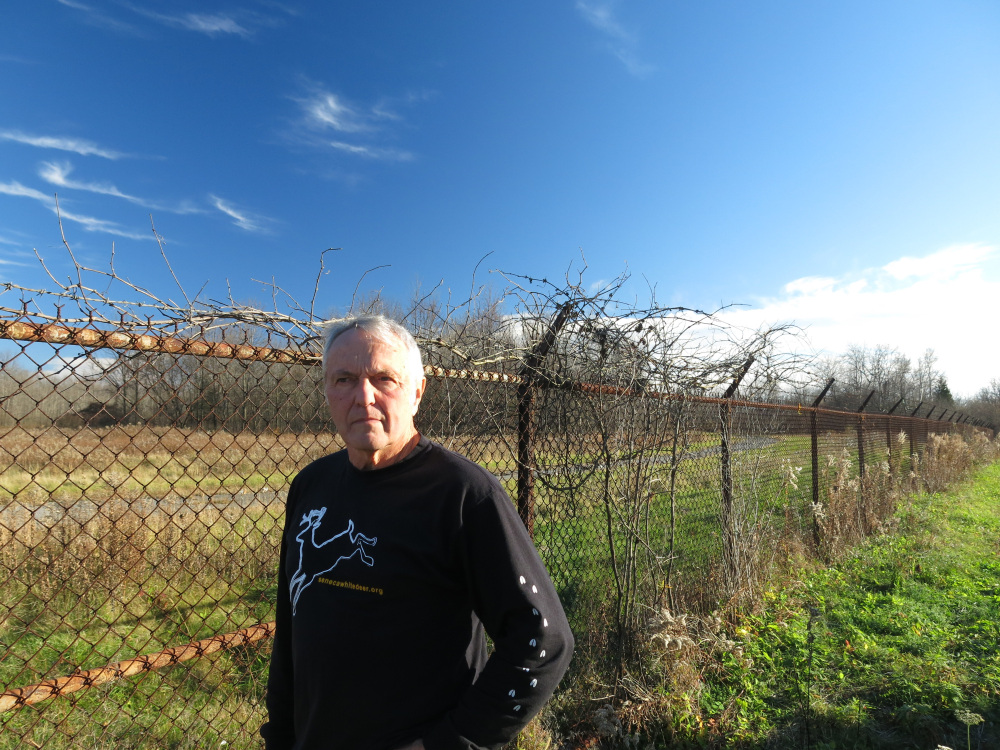ROMULUS, N.Y. — Hundreds of ghostly white deer roaming among overgrown munitions bunkers at a sprawling former Army weapons depot face an uncertain future after living and breeding largely undisturbed since the middle of the last century.
The white deer – a genetic quirk that developed naturally on the 7,000-acre, fenced-in expanse – have thrived, even as the depot itself has transitioned from one of the most important Cold War storehouses of bombs and ammunition to a decommissioned relic.
Now, as local officials seek to put the old Seneca Army Depot up for bids next month, there is concern that the sale could also mean the end of the line for the unusual white deer. A group of residents dedicated to saving the animals has proposed turning the old depot into a world-class tourist attraction to show off both its rich military history and its unusual wildlife. The Nature Conservancy also is looking at options for preserving the largely undeveloped landscape.
“When we ran bus tours on a limited basis between 2006 and 2012, we had people come from all over the United States to see the deer,” said Dennis Money of Seneca White Deer Inc. “People are enchanted by them.”
The white deer owe their continued existence to 24 miles of rusting chain-link perimeter fencing that went up when the depot was built in 1941, capturing several dozen wild white-tailed deer in the area’s extensive woodlands. The white deer are natural genetic variants of the normal brown ones. They’re not albinos, which lack all pigment, but are leucistic, lacking pigment only in their fur.
In the wild, white deer are short-lived, being easy targets for predators and hunters looking for a unique trophy. Small herds of white fallow deer roam protected sites in Ireland and on the campus of the Argonne National Laboratory in Illinois, but the Seneca Army Depot has the largest known population of white white-tailed deer, Money said.
With protection from the Army and its fence, the Seneca white deer have grown to an estimated 200. If buyers take down the fence, the white deer aren’t expected to last long.
For now, the white deer, and about 600 brown ones, roam woods and fields surrounding overgrown weapons storage bunkers, cracked roads and rusted railroad tracks. In the bright sunshine of midday, small groups of deer can be glimpsed in mowed lanes and clearings maintained by the Army. But early morning and evening are the best time to see them, and cars pull over along bordering public highways as people stop to watch. Visitors aren’t allowed inside the fence.
The depot, completed a month before the Japanese attacked Pearl Harbor, provided for the ordnance storage needs of the nation for 60 years. It covered an area larger than the city of Syracuse, 40 miles to the northeast, and stored bombs and ammunition.
Copy the Story LinkSend questions/comments to the editors.




Success. Please wait for the page to reload. If the page does not reload within 5 seconds, please refresh the page.
Enter your email and password to access comments.
Hi, to comment on stories you must . This profile is in addition to your subscription and website login.
Already have a commenting profile? .
Invalid username/password.
Please check your email to confirm and complete your registration.
Only subscribers are eligible to post comments. Please subscribe or login first for digital access. Here’s why.
Use the form below to reset your password. When you've submitted your account email, we will send an email with a reset code.